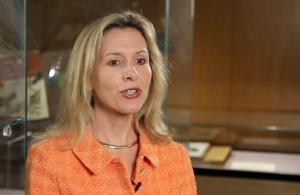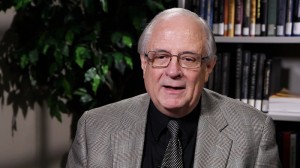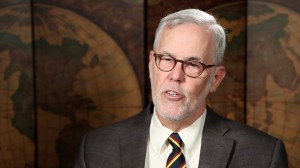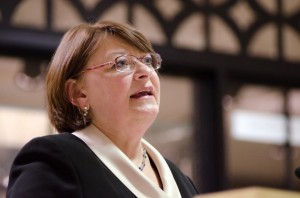James Ford Bell Library was founded in 1953
This year the James Ford Bell Library celebrates its 60th anniversary of preserving and documenting the history of trade around the world.
The Bell Library was established at the University of Minnesota in 1953 through an agreement between the Board of Regents and James Ford Bell, a local industrialist and philanthropist and also a member of the Board of Regents from 1939 until shortly before his death in 1961.
“James Ford Bell was an avid collector,” said Ellen George, President of the Associates of the James Ford Bell Library. “And what he wanted was to share his collection with the public.”
Originally focused on what was known as the Age of Exploration, roughly 1400 to 1800, the Bell has expanded its collecting focus to encompass all pre-modern materials that preserve and document the history of trade and its impact. The collection, currently, consists of more than 30,000 items, ranging from handwritten invoices for goods dated as early as the 5th century to early 19th century accounts of expeditions into the North American wilderness.
The James Ford Bell Library is a key resource for undergraduate students, graduate students, researchers, and the public, said William Phillips, professor emeritus of history at the University of Minnesota.
Supporting education
“[Undergraduates] come into the Bell Library not believing that they can touch materials that are 500 years old,” Phillips said. “And they find that they can and it sparks something in their imagination.”
Phillips and others say that access to primary sources is critically important for students and researchers.
“Nothing really replaces an encounter with original sources,” said Kathryn Reyerson, professor of history at the University of Minnesota. “To hold a document is something that can make a lasting impact.”
“You should be able to look at what people were thinking during the actual time [in history],” said Zoe Hill, an alumna of the University of Minnesota and a member of the Associates of the James Ford Bell Library. “It helps you to weed out biases … And it gives you an opportunity to form your own opinions.”
Carla Rahn Phillips, professor emeriti of history, said that the Bell is an important asset for recruiting graduate students to the University of Minnesota. “Graduate students often choose to come to an institution, such as the University of Minnesota, because of the research opportunities that that institution has,” she said. “The Bell Library is one of our greatest drawing cards.”
Supporting research
Nabil Matar, a professor of English, said without the Bell Library he would not have been able to conduct his research.
“The fact that a particular book is here helps me very much in terms of finding material that somebody else at a different university, which doesn’t have the book, would not find with the same ease,” Matar said.
Carla Phillips said the book she most enjoyed writing was inspired by a packet of materials at the Bell Library. “This was a book called ‘Six Galleons for the King of Spain,’ and the Bell Library, in fact, had the delivery documents for those six galleons,” Phillips said.
Supporting community
It’s important for a research library like the Bell to be housed at the University of Minnesota, a major research institution, said Ford Bell, president of the American Alliance of Museums and Honorary Director of the Associates of the James Ford Bell Library. But he pointed out that the Bell Library is much more than a University resource.
“The Bell Library is also a community resource; it’s a community institution,” he said. “School children come here and learn about discovery and exploration and the importance of trade and commerce. Students participating in History Day use the Bell Library as a resource for their projects.”
In turn, Bell and others say that the Bell Library deserves public and private support in order to be successful.
“[The Bell Library] is a monument. It’s as valuable as any monument that is protected and preserved,” said Matar. “This is an intellectual monument, a monument for the humanities. It’s a monument that should always be preserved because without that we do not know where we came from. And, then, who are we?”
Celebrating 60 years
“Milestones are important,” said Marguerite Ragnow, curator, James Ford Bell Library. “They provide opportunities to come together as a community, to celebrate our common experience, to acknowledge the achievements of those who were key contributors, and to reflect on the future.”
As part of the celebration, the Bell Library has put together an exhibit called, “Bound Fragments of Time: 60 years of Collecting at the James Ford Bell Library.” The exhibit runs through February 1, 2014 in the T.R. Anderson Gallery, 4th floor of Wilson Library.
“This special anniversary exhibition is the result of several years of planning and thinking about how best to represent an astonishingly rich collection that has grown to more than 30,000 items since its inauguration in 1953,” Ragnow said. She added that the exhibit also pays tribute to the process of building the collection and honors those who played a significant role: founder James Ford Bell, curators John (Jack) Parker and Carol Urness, and T. R. Anderson. Anderson was one of the founders of the Associates of the James Ford Bell Library and a key member of Bell’s team.









